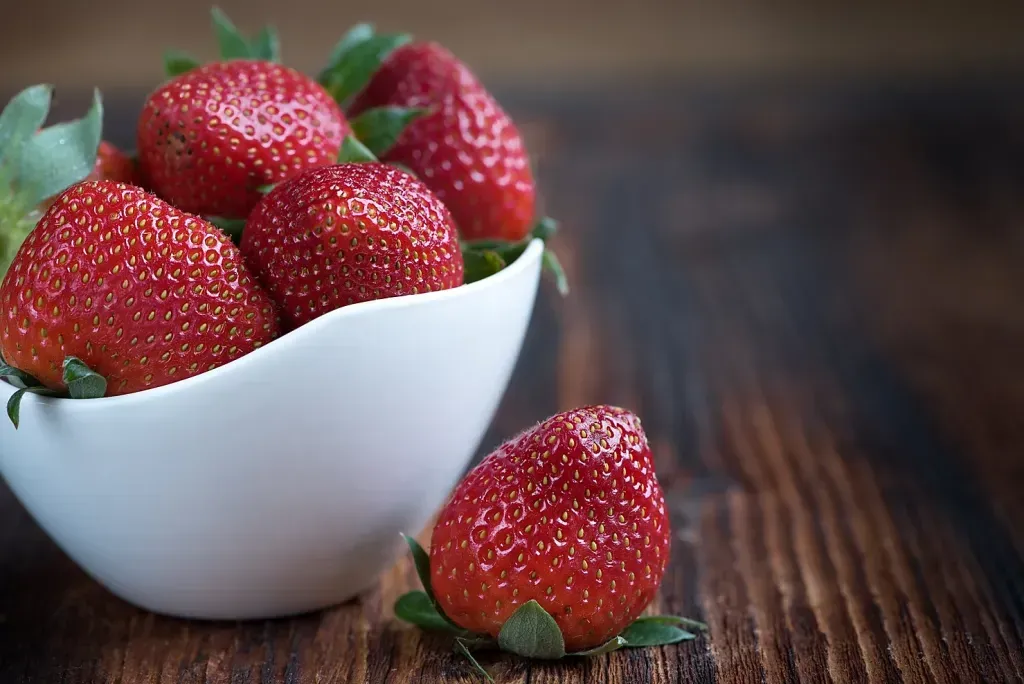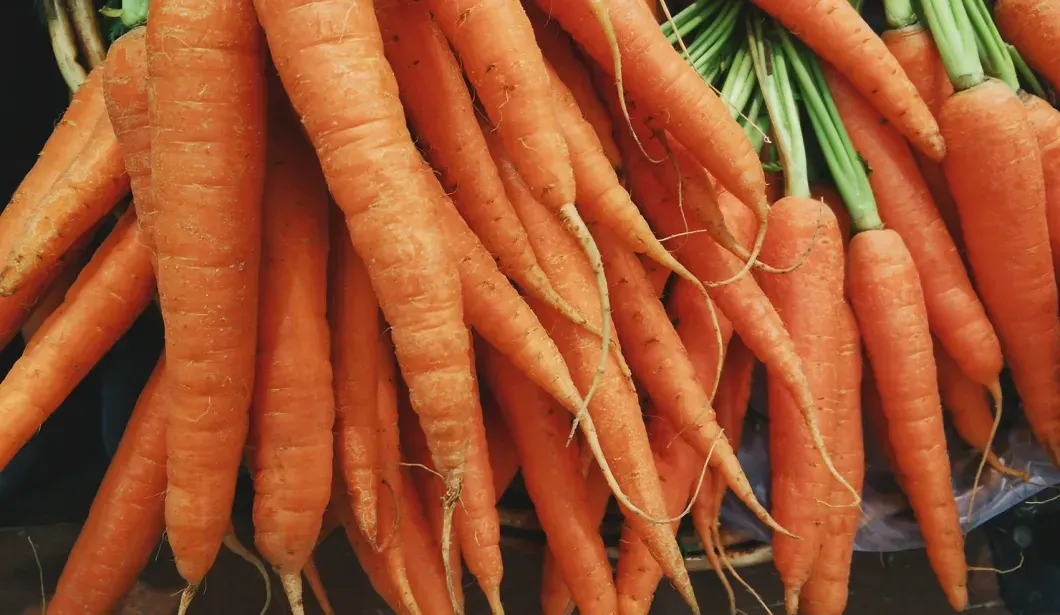Foods for Flawless Skin
Keep your skin healthy and lower your risk of skin cancer with these foods…
Strawberries
Eating more vitamin C-rich foods, such as strawberries, can help protect skin cells, according to a 2015 Study. Vitamin C’s skin-smoothing effects may be due to its ability to mop up free radicals produced from ultraviolet rays and also its role in collagen synthesis. Collagen is a fibrous protein that keeps skin firm, and vitamin C is essential for collagen production.

Red Bell Peppers
They are a tasty vegetable that can be enjoyed either cooked or raw. One red bell pepper contains more than 100% of your daily vitamin C needs. It also contains significant amounts of dietary fibre and vitamin B6. Moreover, it is rich in carotenoids that can help prevent wrinkles and increase blood circulation to your skin, helping it look more youthful. Due to their carotenoids, red bell peppers are also great to fight acne. A red bell pepper is a perfect, low-calorie snack that contains about 30 calories and has a really satisfying, crunchy bite. Keep slices of red bell peppers in the fridge, so you will always have something healthy and tasty to reach for when you are having a snack attack. The fibre that a bell pepper contains will help you to feel full longer with very little calories. Plus, you will have flawless skin!
Dark Chocolate
This is one of our favourite foods to eat every day for perfect skin! Dark chocolate is rich in antioxidants, fatty acids, and flavanols that promote glowing skin. The antioxidants in dark chocolate will help reduce roughness in your skin and protect it against sun damage. Moreover, cocoa relaxes arteries, increasing blood circulation that leads to healthier skin. Cocoa powder or raw cacao has less fat. And if you like dark chocolate, eat your ounce of dark chocolate every day and make sure you choose at least 80% cacao content in order to avoid milk and added sugars found in a traditional chocolate bar.
Chia, hemp, sunflower, pumpkin & flax seeds
These are all great for your skin. Pumpkin seeds and sunflower seeds are both rich in selenium, Vitamin E, magnesium and protein. Selenium and protein keep all wrinkles away, Vitamin E enhances moisture in your skin, and magnesium lowers your stress levels. The healthy Omega 3 fatty acids in flax, chia and hemp seeds are perfect for fighting wrinkles and acne. Plus, these seeds are rich in protein.
Just sprinkle seeds right on top of your salad or oatmeal and enjoy the great taste as well as perfect skin. We like to add seeds to a fruit yogurt or smoothie!
Celery
Another food to eat daily for perfect skin is celery. Many of us underestimate this veggie, but celery contains Vitamin K that keeps the blood circulation healthy and helps to reduce high blood pressure. This can reduce your stress level, and as you know stress can cause bad skin, migraines and even cancer. Celery also contains natural sodium, potassium and water, and can help to prevent dehydration. Dehydrated skin means dryness, flaking, wrinkles, and even breakouts. Make sure you consume celery every day or at least every other day. If you are counting calories, don’t worry, celery is very low in calories!
Papaya
Papaya is a wonderful fruit which has a rich history and numerous nutritional benefits. It is very low in calories (only 39 calories per 100 g!) and also contains no cholesterol. So if you are trying to lose weight, consider eating papaya every day to maximize its health benefits. A great beauty food, papaya is low in fructose and is excellent for digestion! The antioxidant nutrients found in it, including Vitamins C and E and beta-carotene, are great at reducing inflammation and acne. Moreover, Vitamin C may also protect your skin against sun damage.
Carrots
Carrots are good not only for your eyes, but also for your skin. They are especially good for clearing up breakouts. Carrots are rich in vitamin A, and they help prevent the overproduction of cells in the outer layer of the skin. That’s where excess sebum combines with dead cells and clogs pores. Another great reason to snack on some carrots is that Vitamin A reduces the development of skin cancer cells. So make sure you nibble on a half-cup of baby carrots every day for perfect skin.

Spinach
Spinach is a healthy and nutrient-rich food you should certainly include in your everyday diet. You may hate spinach, but it is a wonderful source of iron, folate, chlorophyll, Vitamin E, magnesium, Vitamin A, fiber, plant protein, and Vitamin C. Due to their antioxidant abilities, Vitamins C, E, and A are especially great for your skin. Spinach contains antioxidants that fight against all types of skin problems. Add it to your everyday diet and see what happens. By eating spinach, you’re just cleaning your skin from the inside out! Spinach also boasts lutein, a carotenoid that protects your skin from UV damage. When buying spinach, pick the one right up in the light: new research, published in the Journal of Agricultural and Food Chemistry, reveals that spinach stored continuously under the light for as little as three days boasted higher levels of vitamin C and preserved levels of K, E, folate and the carotenoids lutein and zeaxanthin.
Coconut oil
Coconut oil is one of the richest sources of saturated fat, with about 90 percent of calories as saturated fat. It contains lauric acid, a powerful antibacterial and antiviral agent that keeps away viruses, infections, inflammation and acne. Coconut oil is also rich in essential fatty acids and Vitamin E, which are perfect for keeping your skin moist, soft, and wrinkle-free. Coconut oil is especially good for your thyroid. Plus, there’s considerable evidence that this oil can help lose weight. MCT oil is a great option as well.
Consume coconut oil regularly for clear and lovely skin and healthy and shiny hair! Apply it as a skin moisturizer or lotion, and use it as a hair mask. If you have dry, damaged hair, heat up a little coconut oil, apply to your hair, and wear a shower cap for about 10 minutes. Shampoo and condition as usual for soft, shiny and healthy hair! Believe it or not, but coconut oil can really help slow down aging. Coconut oil contains a high level of antioxidants that protect our skin. It also contains vitamin E, which helps heal and reduce fine lines, scarring, and stretch marks.
Coffee
Drinking a single cup of coffee daily may lower your risk of developing skin cancer. In one study of more than 93,000 women, published in the European Journal of Cancer Prevention, those who drank one cup of caffeinated coffee a day reduced their risk of developing nonmelanoma skin cancer by about 10 percent. And the more they drank—up to about 6 cups or so per day—the lower their risk. Decaf didn’t seem to offer the same protection. Make sure your coffee is Fair Trade!
Tomatoes
Consuming more lycopene—the carotenoid that makes tomatoes red—may protect your skin from sunburn. In one study, participants who were exposed to UV light had almost 50 percent less skin reddening after they ate 2 1⁄2 tablespoons of tomato paste or drank about 1 2⁄3 cups of carrot juice daily, in addition to their regular diet, for 10 to 12 weeks. Supplements, however, weren’t as effective: in the same study, those who received a lycopene supplement or synthetic lycopene weren’t significantly protected against sunburn.
Tofu
Tofu may help to preserve skin-firming collagen because it is rich in isoflavones. In a study published in the Journal of the American College of Nutrition, mice fed isoflavones and exposed to ultraviolet radiation had fewer wrinkles and smoother skin than mice that were exposed to UV light but didn’t get isoflavones. The researchers believe that isoflavones help prevent collagen breakdown.
Broccoli
Eating more vitamin C-rich foods, such as broccoli, may help to ward off wrinkles and age-related dryness, suggests research from 2007 in the American Journal of Clinical Nutrition. Vitamin C’s skin-smoothing effects may be due to its ability to mop up free radicals produced from ultraviolet rays and also its role in synthesizing collagen, a fibrous protein that keeps skin firm.
Pink Grapefruit
Pink grapefruit gets its pink-red hue from lycopene, a carotenoid that may help to keep your skin smooth. In a study published in 2008 in the European Journal of Pharmaceutics and Biopharmaceutics, researchers found that of the 20 individuals studied, those who had higher skin concentrations of lycopene had smoother skin.

Citrus fruits
This tip was one of the most interesting for radiant, healthy skin that I discovered; it’s about eating citrus fruits to help clarify your complexion. It’s a fact that citrus fruits such as lemons and oranges are known to help support your liver and kidneys, which are accountable for detoxing your body, so eat citrus and your skin will feel supple and look better. You should try adding some lemon to your water or eating an orange.
Edamame
Edamame is rich in isoflavones—and isoflavones act like antioxidants, scavenging for and mopping up harmful free radicals caused by sun exposure. Isoflavones may also help to preserve skin-firming collagen—which begins to decline starting in our twenties.
Salmon
The omega-3 fatty acids DHA and EPA (docosahexaenoic and eicosapentaenoic acids, respectively) found in salmon may shield cell walls from free-radical damage caused by UV rays, according to a 2009 study in the American Journal of Clinical Nutrition. Researchers followed the eating habits of more than 1,100 Australian adults for approximately five years and found that for those who ate a little more than 5 ounces of omega-3-rich fish—such as salmon—each week the development of precancerous skin lesions decreased by almost 30 percent. Aim to eat two servings of fatty fish each week: not only are the omega-3s good for your skin, they’re good for your heart too.
Salmon is an excellent food to fight stress, anxiety, and depression. Salmon also provides most of your daily vitamin D needs. And as you may already know, Vitamin D is responsible for keeping your heart, bones, colon and brain healthy. It also helps prevent colon cancer, anxiety, depression, heart disease and bone disease. Salmon is also rich in omega-3 fatty acids that are excellent for fighting inflammation, wrinkles and acne. Its high omega-3 content also helps hydrate your skin from the inside out. Moreover, eating salmon keeps your scalp hydrated and promotes strong, healthy hair. Vitamin D is among the best nutrients for your body and your brain that can be sourced from Vitamin D rich foods, pure sunlight, or supplements.
Green Tea
I drink green tea every day because I know that it is a great source of antioxidants and a unique amino acid, L-theanine that helps relax your body and lower stress. When the tea is hot, the bionic brew releases catechins, a kind of antioxidant with proven anti-cancer and anti-inflammatory properties. Green tea may also reduce your risk of developing high blood pressure. Drink 3 or more cups of tea every day for better results.Green tea has become gradually more popular in western society since scientific research provided concrete proof that it’s a great beverage for maintaining good health. Thus contemporary nutritionists advise drinking green tea on a regular basis. Yet using green tea for its beneficial effects is nothing new. The Chinese have been enjoying the myriad medicinal benefits linked to drinking green tea for several thousand years.
So how exactly does drinking green tea on a regular basis improve your overall health?Green tea is good for your health because it contains a catechin polyphenol called epigallocatechin gallate (EGCG). EGCG is a very powerful antioxidant, and it doesn’t just lower your risk for cancer and heart disease. Including EGCG in your diet also boosts your general immunity, stops blood clots from forming, limits the damage that free radicals do to your DNA, slows down the aging process, and delays the onset of age-related diseases such as Alzheimer’s. Studies also indicate that the EGCG in green tea boosts overall energy levels, and suppresses your appetite so that you won’t feel the need to eat as much, thus reducing your risk of developing hypertension and other obesity-related health conditions.
Water
You’ve heard it since you were a kid, but it really does work. According to the Mayo Clinic, drinking eight 8 ounce glasses of water per day replenishes moisture lost through normal activity. Remember, water is what carries all of the nutrients and minerals to the thirsty cells all throughout your body, including skin cells. Plus, it can help reduce dryness and help with mild acne problems.











